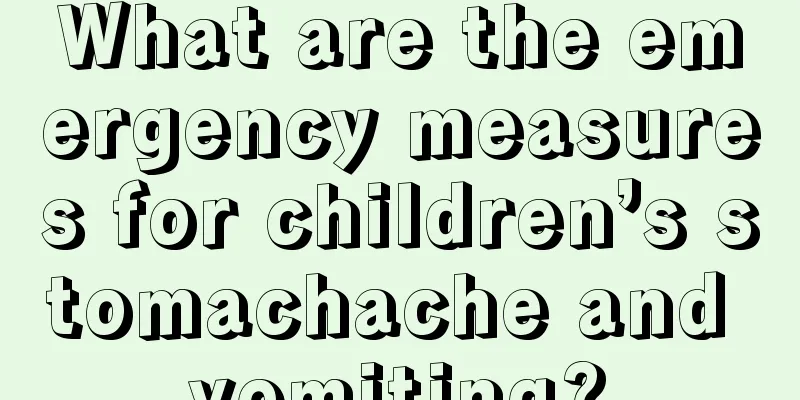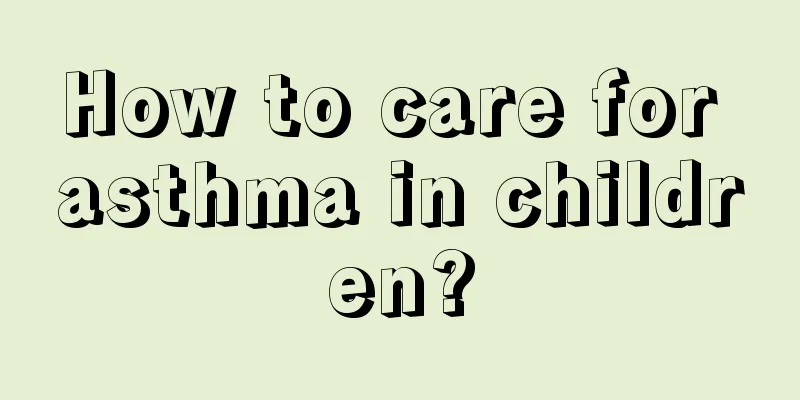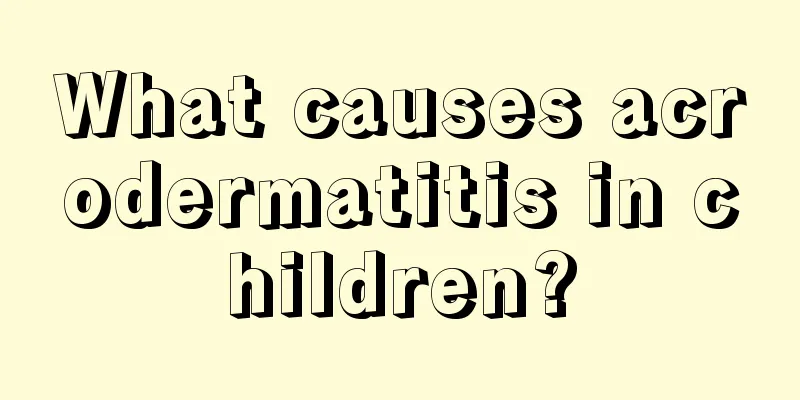What to do if your baby has a blocked nose while sleeping

|
When taking care of their babies, many parents find that their babies have symptoms of stuffy noses when sleeping, which often makes parents particularly worried, fearing that the baby’s sleep quality will be affected by the stuffy nose, thus affecting the healthy growth of the body. There are many reasons for such symptoms. If we want to improve it thoroughly, we must prescribe the right medicine according to the cause. Let’s learn about what to do if the baby has a stuffy nose when sleeping. What to do if your baby has a blocked nose while sleeping The culprit for the baby's breathing problems The nasal cavity is the main channel for babies to breathe. It can moisten and filter the inhaled air and maintain body health. However, babies are prone to the following 5 types of nasal congestion, which lead to poor ventilation. Cold and stuffy nose Because the baby's body temperature regulation center is not fully developed, the nasal mucosa is tender and weak, and the respiratory tract defense is poor, it is easy to catch a cold. Subsequently, acute edema of the nasal mucosa occurs, causing nasal congestion. Symptoms: nasal congestion and runny nose, slightly red sides of the nose, and sometimes accompanied by fever. Prevention and control measures: 1. About half a month after the baby is born, start to supplement cod liver oil in moderation; start to add complementary foods at 4 months and supplement vitamin A. You can feed some liver puree, carrot puree, and vegetable puree to enhance the defense ability of the respiratory tract. 2. When using air conditioning, the temperature difference between indoor and outdoor should not be too large. The baby's room should be around 28 to 30 degrees Celsius. 3. Use a warm, wet towel to apply heat to the baby's nose (not too hot), twice a day, each time for about 15 minutes. Acute sinusitis nasal congestion Repeated upper respiratory tract infections in babies can affect the sinus mucosa, causing it to become congested and swollen, with increased secretions, which can block the sinus openings and cause acute sinusitis. Symptoms: In addition to nasal symptoms such as nasal congestion, runny nose, and mouth breathing, more serious symptoms include fever, headache, sore throat, and irritability. Prevention and control measures: 1. If your baby has a cold, you should actively seek treatment. 2. Once your baby has acute sinusitis, take him to an ENT doctor in time and choose antibiotics reasonably under the doctor's guidance to completely cure the disease and prevent recurrence. 3. If the baby has severe nasal congestion, you can use 0.5% ephedrine furacillin drops cautiously under the guidance of a doctor, one drop in each nostril 10 to 15 minutes before feeding, and it will usually take effect within a few minutes. However, ephedrine has side effects on babies and is not suitable for excessive or long-term use, so as to avoid causing atrophic rhinitis and affecting the olfactory sensitivity of the nose. 4. When your baby has a lot of purulent nasal discharge, you can ask the doctor to do replacement therapy to clear out the purulent secretions in the sinuses. Nasal obstruction The nasal mucosa has a normal amount of secretions every day. Since babies cannot blow their noses, if mothers do not clear the secretions in their babies' nasal cavity in time, the secretions will accumulate in the nasal passages. Over time, the accumulated secretions will dry and harden to form nasal crusts. Symptoms: Nasal crusts adhere to the outer opening of the nasal cavity or deep inside, blocking the narrow nasal passages. Prevention and control measures: 1. Clear your baby's nasal secretions in time. If there is a lot, use a nasal aspirator to remove them. 2. When removing nasal crusts, avoid picking the baby's nose with your hands to avoid damaging the delicate nasal mucosa and causing bleeding and infection. Correct method: If the nasal crust is blocked at the nostril opening, you can use a small sterilized cotton swab to gently roll it off. If the nasal mucus is deeper in the nasal cavity, you can first drop 1 to 2 drops of saline, cold boiled water or breast milk into the nostrils to allow the nasal crust to slowly moisten and soften. Then gently squeeze the nose wings to make the nasal crust gradually loosen, and then use a sterilized cotton swab to roll away the nasal crust. Foreign matter blockage Babies aged two or three are very curious. Sometimes they play with small stones, small building blocks, small whistles, buttons, small erasers, bottle caps, and paper balls, and like to put these small things into their noses. Sometimes they will eat sunflower seeds, peanuts, fried beans, and nuts while stuffing these things into their nasal cavities. Because the baby's nasal cavity is small, once these things are stuffed in, the baby cannot take them out by himself, and he dare not tell his parents, and then forgets about it, so the foreign objects remain in the nasal cavity. Some babies suffer from nasal vestibule eczema, and because of the itching, they use stuffing and rubbing to relieve the itching. Symptoms: Most of the time, one side of the nasal cavity is blocked and ventilation is poor; if secondary infection occurs, the mucus gradually becomes purulent; if the foreign body stays for too long, it can cause erosion of the nasal mucosa, growth of granulation tissue, and bloody nasal discharge with a foul odor. Prevention and control measures: 1. Educate your baby to develop good hygiene habits and not put anything in his nose. If something does get stuck in his nose, tell your parents immediately and remove the foreign object as soon as possible. 2. Parents should pay attention to the baby's breathing condition. If they find that the baby has nasal congestion on one side, or unexplained purulent nasal discharge or foul odor, they should take the baby to see a doctor immediately. Allergic rhinitis, nasal congestion There are two types of allergic rhinitis: seasonal and perennial. Perennial allergic rhinitis can occur throughout the year and is mostly caused by fungi, dust mites, insect secretions, animal fur, etc. Symptoms: obvious nasal congestion, frequent sneezing, and runny nose. Prevention and control measures: 1. Avoid your baby's contact with allergens such as dust, mites, fungi, animal fur, feathers, etc. For example, do not use down pillows, down quilts and Simmons mattresses; do not let your baby get close to pets such as cats, dogs and birds. During the pollen spreading season, do not take your baby to places with lush flowers, plants and trees, and do not pick or smell flowers and plants at will. 2. Frequently remove dust in the room, open windows for ventilation, and keep the air fresh. 3. Do not feed your baby spicy food, fried food or seafood, and do not let him drink beverages excessively; eat more fresh fruits and vegetables, and drink more boiled water. 4. Take your baby outdoors often and develop a good habit of washing face and hands with cold water, which will improve the body's adaptability and resistance to external climate changes and help prevent diseases. 5. Take systemic and local anti-allergic drug treatment under the guidance of a doctor. The above is an introduction to what to do if your baby has a blocked nose when sleeping. After understanding it, we know that there are many reasons for this phenomenon. The choice of method is also very important during treatment. We cannot use drugs blindly. After all, all drugs are toxic. Some drugs, if not used for the right symptoms, will bring certain side effects to the baby. Therefore, seek medical attention in time when symptoms appear. In addition, the baby should be fed more light food in daily diet, and the air in the environment where the baby is located should be kept circulating. |
<<: What to do if your baby doesn't like to laugh
>>: Children's height standard index
Recommend
What causes the baby to have no fetal heartbeat?
The fetal heartbeat is something that babies have...
Children often take deep breaths unconsciously
Sometimes, when parents are accompanying their ch...
Reasons why children have trouble sleeping
Children's physical health is something that ...
Can children sleep on a cool mat?
Children's metabolism is relatively fast and ...
How many months can babies eat rice cereal and add complementary food
Rice noodles are not unfamiliar to many people. W...
What medicine should children take for toothache
There is a saying among the people that toothache...
Is there any trick to stop children from eating milk powder?
When children are weaned, they need to transition...
Is it okay for young children to take a walk after dinner?
For adults, basically taking a walk after a meal ...
Causes of white spots on children's arms
Pay attention when white spots appear on children...
Symptoms of mental retardation
As children grow up, parents need to understand a...
What are some recipes for children to strengthen their spleen and stomach?
If you want your child to develop better and bett...
Treatment for vomiting in six-month-old babies
Recently, the phenomenon of six-month-old babies ...
How to check hormone levels in children
The hormone level in a child's body is an imp...
What are complicated febrile seizures in children?
The health of children in the family may directly...
What are the symptoms of children's tooth replacement?
Tooth replacement is a stage that everyone goes t...









